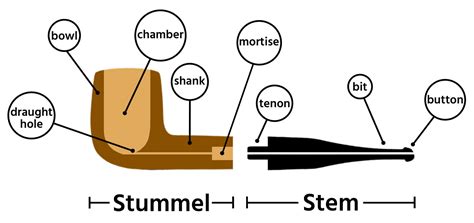Pipe Smoking Like a Pro: Mastering the Stem Fit
Pipe smoking, for many, is a contemplative ritual, a moment of quiet enjoyment. But achieving true satisfaction depends on more than just the tobacco blend; it hinges on the often-overlooked detail of a properly fitted stem. A loose or tight stem can drastically impact your smoking experience, affecting draw resistance, airflow, and even the taste of your tobacco. This guide will explore the nuances of stem fit, helping you master this crucial aspect of pipe smoking.
Why is Stem Fit So Important?
A perfectly fitted stem ensures a pleasurable smoking experience. Here's why:
-
Optimal Draw Resistance: The stem's fit dictates the resistance you feel when drawing on your pipe. Too tight, and you'll struggle to get a satisfying puff; too loose, and you'll experience a weak, airy draw that lacks flavor and character. The ideal fit provides a gentle resistance, a pleasant "give" that enhances the overall enjoyment.
-
Airflow and Cooling: A proper fit facilitates smooth airflow, allowing for even combustion of the tobacco and preventing overheating. A loose fit can lead to uneven burning and a harsh, hot smoke. Conversely, a tight fit restricts airflow, resulting in an unpleasant, strained draw.
-
Flavor Enhancement: The stem plays a surprising role in shaping the taste of your tobacco. Proper airflow, facilitated by a well-fitted stem, allows the nuanced flavors of your blend to fully develop and reach your palate.
-
Preventing Leaks: A loose fit can lead to air leaks, diminishing the enjoyment and potentially causing the tobacco to go out.
How to Check Your Stem Fit: The Simple Test
Before diving into adjustments, you need to assess your stem's current fit. Here's a simple test:
-
Visual Inspection: Carefully examine the tenon (the part of the stem that fits into the shank) and the mortise (the hole in the shank that accepts the tenon). Look for any visible gaps or misalignment.
-
The Wiggle Test: Gently wiggle the stem back and forth. A secure fit should show minimal movement. Excessive movement indicates a loose fit.
-
The Draw Test: Gently draw on the pipe with the stem inserted. If the draw is excessively tight or too loose, adjustments may be necessary.
Addressing a Loose Stem Fit
A loose stem is a common problem, often causing leaks and an unsatisfactory draw. Here are some ways to address this:
1. Using a Stem Liner:
Stem liners are small, typically made of a heat-resistant material such as silicone or PTFE. They are inserted into the mortise, effectively reducing its size and creating a snugger fit for the tenon.
2. Applying a Thin Layer of Pipe Cement:
If the looseness is minimal, a thin layer of pipe cement applied to the tenon before inserting it into the mortise can create a more secure connection. Ensure that the cement is specifically designed for pipe repairs and apply it sparingly to avoid clogging the airflow.
3. Using Pipe Stem Material:
As a last resort and requiring some skill, you can carefully add a thin layer of pipe stem material (if it's the same material as your pipe) to the tenon to increase its diameter slightly.
Addressing a Tight Stem Fit
A stem that's too tight can be just as problematic as a loose one. Here's how to tackle it:
1. Careful Sanding:
Very carefully and minimally sand the tenon using fine-grit sandpaper. Remove only a tiny amount of material at a time, frequently testing the fit. This requires patience and precision.
2. Using a Pipe Reamer:
A pipe reamer is a specialized tool designed for carefully enlarging the mortise. It requires a delicate touch to avoid damaging the shank.
Warning: Improper sanding or reaming can severely damage your pipe. If you're uncomfortable performing these tasks, seek the assistance of a qualified pipe repair professional.
Maintaining a Proper Stem Fit
Regular cleaning and proper storage are key to maintaining a good stem fit:
-
Regular Cleaning: Cleaning your pipe regularly prevents buildup of tars and moisture, ensuring that the stem continues to fit properly.
-
Proper Storage: Store your pipe in a case or pouch to protect it from impacts, which can potentially misalign the stem.
Frequently Asked Questions
What kind of cement is best for fixing a loose pipe stem?
Use a pipe cement specifically designed for this purpose. Avoid using any general-purpose adhesive.
Can I fix a loose stem permanently without pipe cement?
Stem liners offer a reliable non-permanent solution that can easily be removed and replaced if needed.
My stem is slightly loose, but it still smokes fine. Should I fix it?
While it might still smoke, a loose stem is more prone to leaks and an inconsistent draw. Fixing it will prevent future issues.
How do I know if I've sanded the tenon down too much?
If the stem becomes too loose or there are noticeable imperfections on the tenon, you've likely sanded it too much.
Mastering the stem fit is a crucial skill for any serious pipe smoker. By understanding the importance of a proper fit and employing the techniques outlined above, you can ensure a consistently enjoyable and satisfying smoking experience. Remember, patience and attention to detail are key. If you are unsure about any repair, consult a professional pipe repair specialist.

